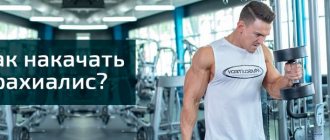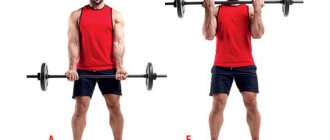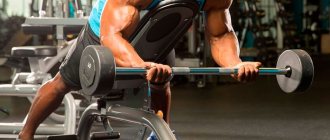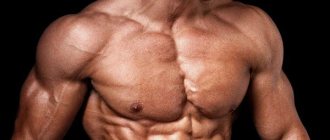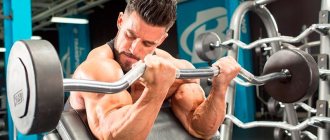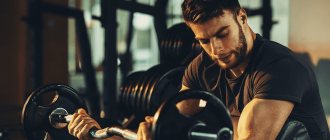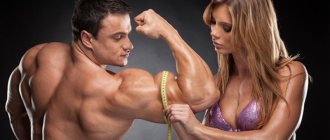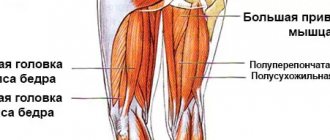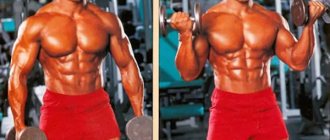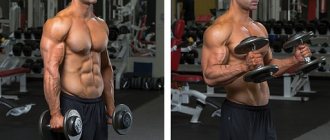To have powerful and pumped up arms, professional athletes pay special attention to pumping up the brachialis . Beginners, in turn, know nothing about this muscle and do not pay due attention to it. What kind of muscle is this, where is it located, what is it responsible for, and what biceps exercises should you do to pump it up?
The brachialis or brachialis muscle is located under the biceps, running in the area of the front of the humerus. It is attached to the tuberosity on the ulna. Simply put, the brachialis is a bulky muscle that, like the biceps, crosses the elbow joint and is involved in flexing the arm at the elbow joint. Thanks to the good development of the brachialis muscle, the arms in the biceps area look much fuller and more attractive. For this reason, all professional athletes perform separate exercises to develop these arm muscles.
The brachialis is a muscle that is practically invisible, especially in ordinary people. At the same time, scientists note that 60-70% of the movement when bending the arm at the elbow is taken away by this muscle, and not the biceps. This has not yet been precisely proven, but we can definitely say that when the limb is flexed at the elbow joint, the brachialis is definitely involved.
Athletes with an imbalance in the development of the biceps and brachialis may experience pain when bending the elbow while performing exercises.
Anatomy of brachialis - structure, functions and location features
The brachialis is located under the biceps brachii between the biceps and triceps muscles, originates from the anterior surface of the humerus, and its attachment point is the tuberosity of the ulna.
The function of the brachialis muscle is to flex the forearm. Brachialis acts as a synergist for biceps and an antagonist for triceps. There is no isolation exercise for the brachialis , but it is involved in absolutely all exercises that require flexion of the forearm. Just like barbell curls and dumbbell curls with your arms in a supinated position, the brachialis also works. However, the shoulder muscle is subjected to even greater load in a pronated position, that is, with an overhand grip or a neutral (parallel) grip.
And also read what muscles are: synergists and antagonists →
Acute and chronic myositis
The intensity of inflammation in the muscles and symptoms can increase at different rates, depending on this, two forms of the disease are distinguished:
- Acute myositis. Manifestations increase over a short time. This picture is most typical for injuries and acute infectious diseases.
- Chronic myositis. Manifestations increase slowly over weeks and months. This often happens if pathological changes in muscles are associated with systemic inflammatory diseases.
Only a clear understanding of the cause of myositis allows us to prescribe the most effective treatment. Visit your doctor and get examined. You can make an appointment with a doctor at the neurology department of the International Clinic Medica24 by calling: +7 (495) 230-00-01
Some types of myositis go away quite quickly on their own and do not even require special treatment. Others are caused by serious reasons, progress over time, and their symptoms cannot always be managed, even with the use of strong medications.
In addition, other diseases, sometimes more serious, may be hidden under the clinical picture of myositis.
Therefore, it is important for the doctor to understand what causes the complaints of the patient who came to see him. This helps prescribe the most effective treatment for myositis
Recommendations for brachialis training
Since the increase in biceps directly depends on the growth of the brachialis, which pushes out the external muscle, arm training must necessarily be accompanied by exercises for the flexors with different grips, and most importantly - neutral and with different equipment.
Thus, not only the usual lifting of barbells and dumbbells should constitute a training plan. A forgotten and rarely used piece of equipment, but very effective for working the shoulder muscles, is the kettlebell. By grasping the core or arms of the kettlebell with a parallel grip, lifting the weight is done more with the help of the brachialis, rather than the biceps. You can also use a barbell for a neutral grip, and even plates, which also provide the necessary grip and load.
You should not train your biceps and brachialis muscles on a separate day more than once a week. Don't forget about the existence of the torso and leg muscles. The fact is that the brachialis is involved in exercises for the back, including pull-ups and rows of barbells and dumbbells to the belt. During leg exercises such as deadlifts or deadlifts, the brachialis also experiences static load when holding weight. Therefore, the muscle must have time to recover; as a synergist, the shoulder muscle experiences a large and regular load while strengthening many muscles of the body. Three exercises for the biceps and brachialis are enough, in which 3-4 sets of 8 to 12 repetitions are performed until failure.
Typical execution errors
Leg muscle exercises for men and women in the gym
The mistake that is most common in this exercise is the excessively heavy weight of the barbell.
The brachialis muscle is small in size, just like the biceps. That is why she is not the strongest.
When lifting a barbell with a reverse grip, the biceps is in a disadvantageous position, so its assistance to the movement is minimal. The entire load is performed by the brachialis and brachioradialis.
The weight of the barbell for lifting with a reverse grip should be medium. The main thing is to accurately direct the load to the target muscles.
Attempts to lift heavy weights in this exercise always result in cheating (violation of technique) or injury to the hands.
Shifting your elbows forward when lifting the barbell up is another common mistake.
When performing the exercise, your elbows are always directed towards the floor. As soon as they begin to move forward, the front deltoids are immediately involved in the movement, which take on part of the load.
By spreading your elbows to the sides when lifting the barbell, you also make the mistake of performing the movement not in an arc, but in a straight line. It turns out to be a type of barbell row to the chin, where instead of the brachialis, the deltoids work more.
To maximally pump the brachial muscle, the elbows are constantly pressed to the body, and the movement is performed in an arcuate amplitude.
The help of the back muscles and even the legs when lifting weights (cheating) is always paired with an excessively heavy weight.
The inability to lift the barbell technically correctly, only with the strength of the brachialis and brachioradialis muscles, involuntarily forces stronger muscle groups to be involved in the movement.
By tilting the body forward at the start in the bottom position and then sharply tilting the body back, the barbell inertially rises upward.
This way you can lift more weight or do more repetitions. But the brachialis is minimally involved with this technique.
Top 7 exercises for the shoulder muscle
Hammer
The parallel grip dumbbell curl targets the brachialis more than the biceps. You need to perform the exercise with concentration, without including your shoulder in the movement. Keep your elbow joints level under your shoulders, bend your elbows to the maximum, maintaining peak tension for 1-2 seconds, and slowly extend your elbows.
Barbell Raise with Handle for Neutral Grip
Load the neutral grip bar with the desired weight, gripping the handles parallel, and lower the bar toward your hips. Exhale as you lift the barbell toward your shoulders, but do not throw the barbell up. Once you've reached full flexion, lower the barbell three times slower than when you raised it.
Kettlebell Curl
The first embodiment has an excellent effect on the brachialis, while training grip strength. It is necessary to hold the kettlebell by the core on the sides, with your fingers stretched as far as possible along the projectile, but not from below. Bend your elbows, keeping them in one place. Perform like a barbell curl.
And also read how to pump up your biceps with a kettlebell →
The second option is to hold the arms at your sides with a parallel grip. Work with a stable body position without swaying.
Curling arms with a plate
The plate curl is an alternative to the kettlebell exercise. Hold the plate with a comfortable grip - with a curved hand on the sides or a pinch grip on top. Select the weight so that the muscles are tired by the last repetitions.
Dumbbell Angle Curl
The exercise can be performed either with a hammer grip or with supination in the middle of the amplitude. Lying at an angle of 45 degrees, lower your arms in a relaxed state. Alternate lifting dumbbells with each hand to your shoulders with a full range of amplitude.
Curling arms with handles of upper blocks
The exercise is performed in a crossover. Having placed the handles on the upper blocks for a comfortable grip, grab each block and stand in the center between them, stretch your arms to the sides. Keeping your shoulder stationary, bend your forearms, bringing your hands toward your shoulders. Focus on contracting your biceps as much as possible, then slowly extend without throwing the blocks.
Curling arms from the lower block of the crossover
The exercise affects the brachialis better with an overhand grip or a parallel grip with a special handle. Take a strong grip with both hands on the block, keeping your elbows close to your body in one position. Bend towards your shoulders. When lowering, it is important to resist the force of the block and slowly extend your elbows.
The exercise can also be performed with one hand, alternating the same number of repetitions on each side. You can replace this option with another exercise that affects the brachialis, curling your arms with a barbell with an overhand grip.
Curved barbell curl with straight grip
The biceps curl is another basic mass-building exercise that targets multiple muscles at once. Using an overhand grip, the athlete can shift the emphasis to the brachialis.
Technique:
- Take a curved bar with an overhand grip.
- Straighten up, bring your shoulder blades together, keep your head straight, bend your legs slightly at the knee joint so that they do not interfere with you fully extending your arms.
- As you exhale, lift the projectile up, feeling the tension in the main muscle groups.
- As you exhale, slowly lower the bar to the starting position.
In all the previously listed exercises, try not to use cheating: do not jerk or help yourself with your body in order to make the exercise easier. This will significantly reduce its effectiveness!
Ways to enlarge your forearm at home
Forget wrist straps.
Wrist straps relieve the load on the forearms and compensate for a weak grip, but in this case the muscles of the forearms are weakly loaded. To properly work out the forearms, maximum muscle contraction is necessary, which is impossible with belts. Buy collapsible dumbbells. With this amazing equipment, you will have a lot of opportunities to quickly pump up your arm muscles at home, diversify the number of available movements with new exercises and complexes with dumbbells for the arms.
Use a thick bar. This will make your grip more difficult, and as a result of regular training, the size of your forearm will increase. If you don't have a thick bar at hand, simply wrap a towel around a regular bar. Similar equipment can be thought of at home.
Useful video from Yuri Spasokukotsky on developing grip and forearm strength using the Axel Apollo deadlift.
Wind the rope onto a weighted roller. Stand up straight and grab the roller with your palms facing down. Raise your arms parallel to the floor. Start winding the rope onto the roller by turning each hand up and down in turn. When the weight reaches the roller, slowly unwind the rope using the same wrist movements.
Winding rope onto a wrist roller
Essentially, this device is a heavy plate attached to a small handle with a thin rope. Slowly raise the handle with straight arms to shoulder level and begin to wind the rope onto the roller by turning your hands. When the weight reaches the roller, slowly unwind the rope with reverse movements of your wrists. Then relax and repeat the exercise.
Box. Hitting the punching bag repeatedly will also help develop forearm strength. Incorporate these exercises into your program from time to time and you will soon see progress. For example, 50 uppercuts with each hand perfectly develop the forearm flexors.
Use isometric exercises. Sets of isometric exercises for the forearms allow you to strengthen the muscle frame, increase strength and improve athletic performance without grueling hours of training in the gym. Its effectiveness and accessibility to everyone has been proven over time, as well as its widespread use in yoga, bodybuilding, fitness, rehabilitation programs, martial arts and strength training.
Palms folded into a spire
By putting his fingers together, with his palms apart, the speaker wants to show his confidence and awareness of the issue. Perhaps he wants to emphasize significant points in his speech or wants to convince his interlocutor that he is right. If the speaker's head is slightly tilted back, this can be interpreted as a feeling of superiority.
This gesture has two options; when your fingertips point up or down. The first is usually used by people who want to express their thoughts, and the second by those who are listening. In the latter case, the gesture is regarded as negative and means that the interlocutor has his own opinion about what was said. It is no longer possible to convince him, since, as in the first case, this position of the hands indicates confidence in his decision.
